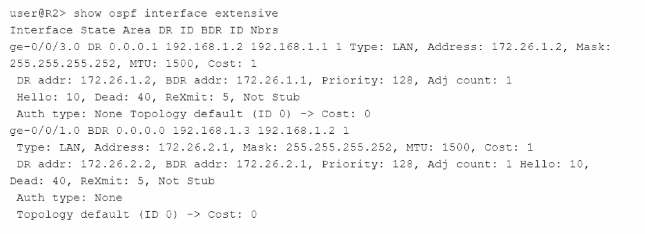Master Juniper JN0-363 Exam with Reliable Practice Questions
Exhibit

Referring to the exhibit, which two statements are correct? (Choose two.)
Correct : C, D
You can see area 0.0.0.1 set for one interface and area 0.0.0.0 for the other interface. This means the router communicates in the backbone and area 1, thus it is an ABR.
Default hello timer and dead intervals are configured
hello-interval---Specifies the length of time, in seconds, before the routing device sends a hello packet out of an interface. By default, the routing device sends hello packets every 10 seconds. The range is from 1 through 255 seconds.
dead-interval---Specifies the length of time, in seconds, that the routing device waits before declaring that a neighboring routing device is unavailable. This is an interval during which the routing device receives no hello packets from the neighbor. By default, the routing device waits 40 seconds (four times the hello interval). The range is 1 through 65,535 seconds.
Start a Discussions
How does a Junos device learn about MAC addresses when II is first connected to an Ethernet LAN?
Correct : D
Start a Discussions
Which two statements ate correct about the BGP next-hop attribute value? (Choose two.)
Correct : B, C
By default, the router that originally sourced the route into BGP places its peer address into the attribute field. The next-hop value is then typically changed when the route is transmitted across external gGP (EBGP) links. Internal BGP (IBGP) peers do not alter the next-hop value between themselves.
Start a Discussions
Exhibit

Referring to the exhibit, what must be included in the Route1 configuration when establishing an EBGP session with the ISP?
Correct : A
Start a Discussions
You are asked to configure filter-based forwarding on a Junos device.
Which two statements are correct in this scenario? (Choose two.)
Correct : C, D
To configure filter-based forwarding, perform the following tasks: Create a match filter on the ingress device. To specify a match filter, include the filter filter-name statement at the [edit firewall] hierarchy level. A packet that passes through the filter is compared against a set of rules to classify it and to determine its membership in a set. Once classified, the packet is forwarded to a routing table specified in the accept action in the filter description language. The routing table then forwards the packet to the next hop that corresponds to the destination address entry in the table. Create routing instances that specify the routing table(s) to which a packet is forwarded, and the destination to which the packet is forwarded at the [edit routing-instances] hierarchy level.
Start a Discussions